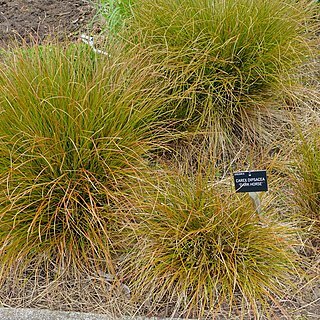Tufts dense, harsh, (25)–30–75–(90) cm. high, light green or reddish. Culms (0.5)–1–2 mm. diam., trigonous or subtrigonous, smooth or occ. slightly scabrid towards infl.; basal sheaths dark brown, red-, yellow-, or grey-brown, nerves ± distinct. Lvs ∞, > culms, 1.5–2.5 mm. wide, channelled, margins closely scabrid. Spikes 4–8, upper approximate, ± sessile, lower 1–3 us. more distant, shortly pedunculate, erect; terminal spike male, occ. with female fls intermixed, remaining spikes female, often male at base; lower spikes (1)–2–2.5─(4) cm. × 4–6 mm., upper spikes progressively smaller. Glumes ± = or slightly < utricles, orbicular-ovate, obtuse, membr., creamy brown or darker flecked, midrib light brown, 3-nerved, not reaching margin or in some glumes produced to a very short mucro. Utricles (2)–2.3–2.8 × c. 1.5 mm., crowded on spike, spreading when ripe, unequally biconvex or almost plano-convex, elliptic-ovoid, yellow-brown at base, upper half with darker red-brown markings and us. scabrid margins, shining, smooth, abruptly narrowed to a small cream bifid beak c. 0.2 mm. long, margins and orifice faintly scabrid. Stigmas 2. Nut slightly > 1 mm. long, biconvex, ellipsoid, cream at first, later very dark brown.
More
Harsh, light green or reddish tufts to 75 cm high. Female spikes 2-5, ± distant, ± sessile, ± 2.5 cm × 5 mm, red-brown. Glumes obtuse, membranous, midrib often not reaching margin. Utricles crowded, spreading when ripe, margins usually scabrid. Stigmas 2.

